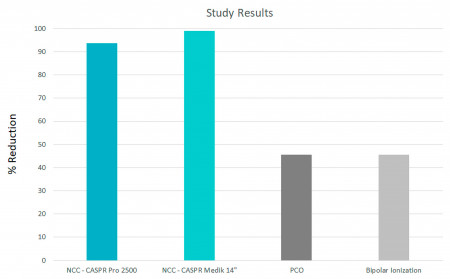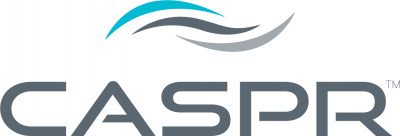Independent Lab Tests Prove CASPR Technology Beats Competitors

DALLAS, March 29, 2022 (Newswire.com) - Environmental health technology company CASPR Technologies has beat two competing technologies in independent laboratory testing. Kansas-based Aerosol Research and Engineering (ARE) Laboratories tested CASPR technology against air and surface purification units from two other companies and found that CASPR Tech's models topped out at a 99% reduction in pathogens compared to its competitors' 45% reduction.
CASPR - which stands for Continuous Air & Surface Pathogen Reduction - uses proprietary Natural Catalytic Conversion (NCC™) technology, which uses photocatalysts to convert the moisture in the ambient air into low levels of gaseous hydrogen peroxide. These highly effective oxidizing molecules blanket the surface of the targeted area and eliminate air and surface pathogens, including bacteria such as MRSA and viruses such as influenza and SARS-CoV-2. Competitor A uses a photocatalytic process with different catalytic coatings and light frequencies than the NCC™ technology that may generate different chemical outputs and contaminants. Competitor B uses a process called bipolar ionization to produce positive and negative ions.
The FDA-compliant laboratory conducted testing on four newly manufactured disinfection units: two CASPR Technologies models, and two competing models. The two CASPR Tech models used were CASPR PRO 2500 and CASPR MEDIK 14". All four units were tested in a 16m3 stainless steel bioaerosol chamber using a partial duct HVAC system. Each unit was placed in the chamber and given 16 hours to reduce pathogens in the air and on surfaces. The pathogen was the same for all tests - MRSE, a common bacterium that serves as a surrogate for bacteria including MRSA.
The specific results:
- CASPR Pro 2500 reduced pathogens by 93.6%
- CASPR MEDIK 14" reduced pathogens by 99.0%
- Competitor A's photocatalytic unit reduced pathogens by 45.5%
- Competitor B's bipolar ionization unit reduced pathogens by 45.6%
"Independent testing is the only way to know what truly works. The value proposition of the NCC™ technology continues to prove that it is the best path forward when talking about reducing pathogens on surfaces and in the air," said CASPR Technologies co-founder Dr. Christophe Suchy, who invented the technology.
CASPR Tech differs from other air purification technologies on the market in two important ways: First, the technology acts continuously, as opposed to a filter, which episodically cleans the air; and second, it also protects surfaces from harmful bacteria and viruses. CASPR's revolutionary technology provides continuous intervention that delivers effective oxidizing molecules to all surfaces including walls and floors reducing bioburdens 24/7.
"In our independent study, the CASPR MEDIK 14" and CASPR Pro 2500 showed more than twice the efficacy of Competitors A and B in reducing the levels of MRSE found in the testing room," said Andrew Dexter, the staff research scientist with ARE Labs who conducted the testing. "These results suggest that NCC™ technology performs better than bipolar ionization and photocatalytic processes at reducing pathogens."
Press Contact: Kelly Hunter, khunter@sunwestpr.com
Source: CASPR Technologies
